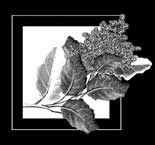
Te Marama o Matariki He Maramataka Mäori - Mahuru
4th Month of the Mäori Year - September/October
Ka hoki mai te Pïpïwharauroa i tönä rerenga ki tawhiti nui ki tawhitiroa. Kua hoki mai ki töna wähi whänautanga, ki te whanau i öna hëki. E püäwai ana te Köwhai, te Puawananga me te Rangiora. Kua aata ara mai a Papatüänuku i tönä moenga roa o te Hötoke. Ka tïmata ngä mahi ki te whakatikatika i ngä mära kai.
Shining Cuckoo return from their migration to lay eggs in the place of their birth. Köwhai, Clematis and Bushmans Friend are now in flower. Earth slowly wakes from a long winter sleep and the ground is prepared for gardens.
Te Tohu o Kaupeka - Rangiora
Sign of the Season - Bushmans Friend
(Brachyglottis repanda)
‘Me te rau Rangiora’
‘Like Rangiora leaves’
This whakatauäkï (proverb) is a reference to the colour of clouds, snow, the crest of the oceans waves, and breast feathers of some birds being likened to the white undersides of the Rangiora leaf.
The underside of the leaves were used as pages for writing on, hence the term Pukapuka, or book
When Rangiora bursts into flower the life force returns to the earth and gardens are prepared for planting.
Rangiora, a native of New Zealand, can be found growing with one or more thin trunks as a small shrub, or tree to 7m tall from sea level to 750m in the North and upper South Island forests, regenerating bush, lowlands and coastal regions.
Rangiora, known also as Pukapuka, Aorangi, Whärangi and Raurëkau, is covered profusely in clusters of tiny cream coloured sweet-scented florets from Mahuru (4th Matariki month) through to Whiringa-ä-rangi (6th Matariki month). Its has broad dark green leathery wavy-edged leaves with soft, deeply membraneous white felt undersides.
The leaves of Rangiora were sacred to Mäori. They were used in ceremonies to clothe the souls of the dead for their journey to the place of departure and babies were wrapped in the leaves upon birth. Mäori also used them for clothing and rites for appeasing the Atua. Leaves were upturned and placed along paths for hunters to see in the night. They were used to line kete for pua bread made from the pollen of raupö and to wrap food in for hangi. Rangiora was also used as rongoa, traditional medicine, though should never be swallowed as all parts of the plant are poisonous, particularly the flowers and sap.

